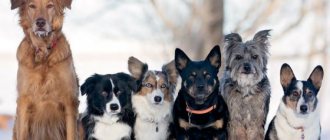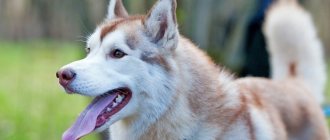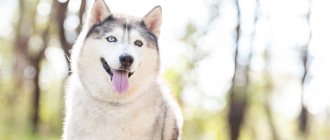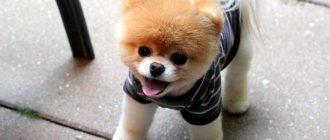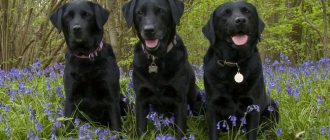If you like low temperatures and wet snow, your pet should suit your preferences. “Basically, a dog that is comfortable in snowy areas has a thick coat that protects it from the elements,” says Bernadine Cruz, a veterinarian with experience working with Arctic dogs. “Representatives of northern breeds often have strong, fluffy paws that allow them to move through the snow.”
If you live in the mountains or are looking for a furry friend who will warm you with their warmth during winter hikes, take a closer look at the northern breeds - they are best suited for these purposes.
Akita
The Akita is truly a royal dog from Japan, where previously only members of the imperial family could own it. Akita statues were given as gifts for the birth of a child. They were believed to bring health, happiness and long life.
Representatives of the breed, originally bred for hunting in harsh weather conditions, have a thick undercoat and a hard top coat. Their hallmarks are independence and stubbornness, but at the same time, pets are loyal to their family and strive to protect its members.
Character
The Northern Inuit dog generally lacks the aggressiveness of its wild ancestors and usually forms endearing bonds with its human companions. She strives to always be among members of her human pack, so she tends to experience severe anxiety if she is forced to spend most of her time alone. She loves to frolic with children and usually even welcomes their rough games. However, families with very young children should think twice before getting this dog as it is too energetic to interact uncontrollably with a toddler. In addition, a puppy of this breed must undergo timely and extensive socialization in order to become a well-mannered member of human society.
As a rule, the Northern Inuit Dog is always happy to meet people, whom he usually greets as old friends. However, some of its representatives show nervousness or shyness in the presence of strangers. Due to its friendly disposition, this breed will not make a good guard dog. At the same time, this dog can be trained into a very reliable watchman, because it is endowed with both vigilance and a desire to please.
The Northern Inuit dog is great for families who already have other dogs as pets, as it is distinguished by a very friendly attitude towards its relatives. However, keep in mind that this dog always seeks to establish its status in the pack hierarchy and may enter into conflict with unfamiliar dogs in order to assert its power over them. To avoid unpleasant incidents with any type of animal, always keep your pet on a secure leash in public places. That being said, there is a good chance that this dog will not be a nuisance to your indoor cat if you introduce the animals to each other at an early age.
Alaskan Malamute
A breed bred to transport heavy loads and as a sled dog, it is ideal for living in cold climates. “The Alaskan Malamute is resistant to cold, which is due to its origin (Alaska is its homeland). The breed is the oldest Arctic dog used to transport cargo in the Arctic, says Gina DiNardo, vice president of the American Kennel Club. “The Malamute’s thick, coarse coat allows them to retain heat.”
Unrecognized breeds and varieties
Unrecognized sled dogs are less popular. Because of this, some of them are on the verge of extinction. These breeds include the following:
- Alaskan Husky. A close relative of the Siberian Husky and Malamute, which is popular in the USA. Capable of reaching speeds of up to 50 km/h.
- Sakhalin Husky. The largest representative in harness racing. Despite the name, the breed is bred by the Japanese.
- Mackenzie River Huskies. Includes several populations of dogs from North America. It has a slender build and long, hanging hair.
- Norwegian sports mestizos (graysters). They were obtained by crossing German Shorthaired Pointers, Greyhounds and Pointers. Used for competitions involving towing skiers and cyclists.
- Chinook. Bred by an American dog handler. It differs from standard breeds by resembling a retriever. In addition to transporting goods, the Chinook is used to rescue people under rubble.
- Kamchatka sled dog. For a long time they were used by Kamchatka mushers, but in the post-war years they were almost completely destroyed. In the early 1990s, the breed began to be actively revived, but due to the lack of purebred individuals, Alaskan huskies had to be attracted.
- Laponese sled dog. Bred by the Sami living in northern Sweden. Due to its small numbers, it has no standard and is close to extinction.
- Taimyr sled dog. An indigenous breed from Taimyr, which gained recognition in Europe thanks to the French traveler. Outwardly it resembles a wolfhound.
- Chukotka sled dog. It is close in appearance to the Siberian Husky, but has more developed working qualities.
- Siberian (Seppala) sled dog. Bred in Canada. It does not have show class and is intended exclusively for work.
The breeding of these animals is mainly carried out by enthusiasts.
Transporting puppies to other regions is expensive and problematic, so most of the listed four-legged animals are known only in their homeland.
American Eskimo dog
The breed, developed in Germany, was originally called the White German Spitz, but after World War II it was renamed the American Eskimo Dog, which most likely refers not to the Eskimos, but to the white color of the animal's coat.
Although it is a playful dog of small size and was once used to perform in the Barnum and Bailey Circus, it is more suited to outdoor activity; The animal's fur is resistant to getting wet, and its thick ears remain warm at low temperatures.
Anatolian Shepherd
This is a serious rock breed, the representatives of which are harsh, hardy, agile and capable of covering long distances. Used in Turkey over 6,000 years ago to guard herds, the Anatolian Shepherd has low energy levels but strong protective qualities. From an early age, she needs to understand who is in charge in the house, and the owner needs to introduce the serious guard to new guests.
Bernese Mountain Dog
This breed combines strength, speed, agility and devotion to its owner. At the same time, animals have a mild temperament and do not require a lot of exercise.
Bred in Switzerland as draft dogs and as sled dogs, Bernese Mountain Dogs are large and strong animals, and therefore are capable of carrying heavy equipment (both their own and part of their owner's).
Taimyr sled
The formidable-looking dog is a real northern wolfhound. The indigenous breed of sled dogs of the peoples of the Far North was included in the State List of breeding achievements approved for use since 1993. A French traveler purchased several animals in the village of Volochanka from local residents and took them out of Russia. The dog received European recognition and participated in exhibitions in France. Now volunteers in Taimyr are trying to restore the breed of individuals exterminated by vagabonds.
Chow chow
These dogs are best known for their black tongues and "wool coat" that makes them extremely resistant to the cold. “If you like to be outside and own a Chow Chow, by all means take him where there is snow,” says Pat Foose, a breeder of the breed in Colorado. “These animals are extremely happy to spend time with their loved ones.”
German Shepherd
The breed gained its popularity after the appearance on screens of Rin Tin Tin, a stray German shepherd puppy found during the First World War and becoming a character in television shows and films.
Representatives of the breed are excellent shepherds, security guards and police officers. They are strong, agile, hardworking, energetic and learn new things quickly.
German Shepherds are prone to hip dysplasia; To avoid these health problems, you should purchase a purebred animal only from trusted breeders.
Greater Swiss Mountain Dog (Grand Bouvier Swiss)
The Swiss was originally known as the "poor man's horse" and was used to carry heavy loads by farmers, shepherds, traders and even the Swiss during World War II. Despite the fact that representatives of the breed are large and powerful dogs (their weight is in the range of 38-64 kg), they have a gentle character and do not need constant exercise.
The Greater Swiss Mountain Dog makes an excellent herder, as well as a hiking companion who will willingly help with carrying (and transporting) equipment.
Greenland sled
Dogs of this rare breed, whose homeland is Denmark, have long served people faithfully. They are classified as Spitz dogs. They are freedom-loving, make their own decisions, and follow the owner’s commands if they do not contradict their attitude. Greenlanders are valued for their beauty, powerful build, developed muscles, and strong limbs. They are smart, freedom-loving, independent, do their work conscientiously, and are in good health. These are real hard workers: they serve in the police, herd herds, and work as guides. They simply need to be trained regularly; it is not advisable to keep them in an apartment or enclosure.
Pyrenees Mountain Dog (Great Pyrenees)
Used to herd livestock on the steep mountain slopes of France, Pyrenean mountain dogs are capable of negotiating dangerous terrain and difficult terrain.
These large animals, weighing 36-45 kg, are elegant and calm, which is why they were chosen as the royal dog of the French Republic. “Great Pyrenees are the most gentle of the guard breeds, the longest living of the giant dogs, and yet they do not require special care,” says Carrie Stewart Rarks, president of the American Pyrenees Mountain Dog Breeders Club. – These animals love winter; their thick, double-layered coat provides protection from extreme cold (except in the lowest arctic temperatures).”
Karakachan dog
Also known as the Bulgarian Shepherd, the Karakachan dog (the second option is correct) is a natural guardian of livestock. She is efficient, loyal to her family members and has developed protective instincts.
Weighing from 36 to 55 kg, these intelligent dogs love to spend time outdoors and are reluctant to be indoors all day long. Large pets do not seek shelter even during rainy and snowy weather, preferring to sleep outside.
Russian President Vladimir Putin has been the owner of a Karakachan dog since 2010.
Wolfspitz (Keeshond)
The thick coat and fluffy undercoat allow this extremely affectionate dog to withstand extreme temperatures and harsh weather conditions; Other advantages of the breed include its unusual, attention-grabbing colors.
“The Keeshond has a very thick coat, which allowed it to stay warm while working as a guard dog on Dutch river boats,” says Dinaro. It is interesting that at one time the People's Party of the Netherlands made the Keeshond its symbol.
Wolfspitz are friendly, quick to learn and active animals. Despite their energy, they can behave calmly at home. These dogs need little exercise, but without it at all, Keeshonds will literally spin around like a top.
Kuvasz
According to the requirements of the American Kennel Club, Kuvasz must have only white color. This dog’s homeland is Tibet, and the name is translated from Turkish as “armed guard of the nobility.” In the past it was owned by members of the Hungarian royal family. Later, representatives of the breed became common as hunters and shepherds.
The Kuvasz's double-layer coat makes them excellent mountain dogs, and their quick learning, fearlessness and strong protective instincts make them an ideal furry companion.
Energetic and potentially destructive, kuvaszs require space, such as a fenced-in yard.
Results
The leading features of the Siberian Husky breed are: proportional build, compactness, strong bones and excellent coat, correct set of ears, neck and head, balanced and peaceful disposition.
For a smart person who has the ability to pay enough attention to his pet, this dog will become an irreplaceable, devoted friend and companion.
Did you like the article? Share it with everyone! Thank you!
- Common dog breeds German Shepherd (Deutscher Schaferhund; German Shepherd)
- Working dog breed, Doberman Pinscher (Dobermann)
- Herding and working dog breed Rottweiler
- Dog breed Giant Schnauzer, large
- Dog breed Caucasian Shepherd Dog
- Greater Swiss Shepherd (Grosser Schweizer Sennenhund)
- Briard dog breed and Brie cheese production
- Boxer dog breed (Deutscher Boxer), strength and courage
- Dog breed Great Dane (Great Dane), the largest
- Collie dog breed and the name of the Scottish sheep
- Dog breed Saint Bernard, monk dog
- Newfoundland dog breed, island dog (Newfoundland)
- Dog breed Komondor, home guard and shepherd
- Dog breed English Bulldog
- Dog breed Labrador Retriever
- Dog breed Dachshund (Dachshund), burrowing hunting dog
- Dog breed Fox Terrier and its varieties
- Dog breed Laika (Laika; Russian-European Laika; West Siberian Laika)
- Decorative dog breed Sheltie, mini collie
- Dog breed American Cocker Spaniel, American
- Dog breed Yorkshire Terrier
- Dog breed Pug (Pug), cheerful and loving
- Herding or water dog breed Poodle (Caniche)
- Elegant dog breed Dalmatian or Dalmatian (Dalmatinac)
- Chow-chow dog breed, which has a blue tongue
- Dog breed French bulldog (Bouledogue francais)
- Dog breed Maltese, little miracle
- Pekinese dog breed as an incarnation of Buddha
- Popular breed in Europe: Miniature Schnauzer (Zwergschnauzer)
- Cute and charming dog breed Chihuahua (Chihuahua)
- Dog breed Siberian Husky
- Akita Inu - the treasure of Japan, features and advantages
Newfoundland
These wonderful family dogs have low energy levels, but are full of friendliness and caring. Fluffy giants, whose weight can reach 68 kg, are calm and patient.
“Newfoundlands’ thick coats protect them from the icy waters they were originally bred to work in,” DiNardo explains. These Canadian dogs are still used today during water rescue operations; Having a two-layer “fur coat” and a strong body, they also feel great in the mountains.
Newfoundlands have a good quality - they almost never bark. However, future owners of a furry giant should take into account that this pet has profuse salivation.
Norwegian Elkhound
“An ancient Scandinavian breed with Nordic features was used in the past for hunting in cold climates,” says Dinaro, adding that this influenced the dogs’ characteristics. They are energetic and, due to the peculiarities of their coat, are always ready to work in snowy areas (the top layer of their coat is smooth, and the undercoat is very thick).
The original purpose of the Norwegian Elkhound is elk hunting. Currently, this dog is an excellent walking companion, with agility, endurance and a desire to protect its owner.
Yakut Laika
The Yakut Laika appeared in the north-east of Russia in the area of “dog rivers”. Pets were used for sledding and hunting large animals. Externally, the Yakut Laika has a medium size, strong paws, thick coat of spotted color (white-black, black-red). The pet easily tolerates any climatic conditions and is quite hardy.
https://youtu.be/ugnGhpr9wLw
Saint Bernard
The St. Bernard gained its fame in 1992 after the appearance of a film in which the main character was the super slobbery and always causing problems Beethoven. Of course, not all St. Bernards are capable of causing a stir, but representatives of the breed have the same impressive size - their weight is 54-91 kg.
Fluffy giants do not have energy and are not prone to active games, but they are truly loyal, strong and ready to travel kilometers in search of missing people.
Samoyed dog
Who wouldn't want to wake up in the morning with a Samoyed smile? This playful and gentle pet is an ideal companion. But do not forget that it requires a lot of physical and mental training.
The dog, originally from Siberia, was bred to herd reindeer, hunt and work in a sled. Nowadays, compact, graceful and cheerful Samoyeds have become popular pets.
Lapinporokoira
Lapinporokoira or Lapp Reindeer Dog appeared artificially after the selection of aboriginal hunting dogs of the north. After the ancient tribes began to breed large animals, the reindeer herding dog began to be used for herding and sledding. For some time the breed was on the verge of extinction. Externally, it is of medium size, muscular paws, and thick black fur.
Shiba Inu
The Shiba Inu has a thick, two-layer coat. This dog is energetic, talkative and always ready to explore.
“Goku loves snow,” the owner of a 2.5-year-old dog says about his pet. - I call it playfulness - he can frolic all day long. “I have a lot of videos of Goku bathing in the snow, and he also likes to look for things in the snowdrifts.”
How to choose a puppy
If you decide to get such a dog, you need to carefully choose it. A husky puppy must be purebred, with a pedigree. Only this can guarantee the presence of characteristic behavioral features. They buy a baby at 2-3 months of age.
Husky puppy
It is advisable to immediately determine the gender of the pet. Males are calmer, but willful and less amenable to training. Bitches are obedient, but cunning and go into heat twice a year. The puppy must be examined before purchase. He must be cheerful and active. The absence of dandruff, nasal or eye discharge is important.
What is the price
The price of a good puppy cannot be low. A dog without a pedigree can be purchased for 6-10 thousand rubles. But she may turn out to be not purebred, with defects or genetic pathologies. Therefore, it is better to buy a puppy from a kennel. Its cost will be higher, but there is a guarantee that the pet will delight its owners with its cheerful, mischievous disposition and unusual appearance. The price of puppies with a pedigree starts from 20 thousand rubles. Premium class show dogs cost at least 50 thousand.
Huskies are popular dogs, beautiful and smart. Even their high price does not stop many. But not everyone can have such a pet. You should not give a husky to a child, or bring it into a small apartment, an elderly person or a homebody. It requires great physical activity, proper upbringing and respectful attitude. Only then will this dog become a beautiful companion, obedient and loyal.
Siberian Husky
The dog is native to Northeast Asia and is another breed that has been used in sled dogs. “The huskies I worked with were very talkative,” says Cruz, a veterinarian who has experience working with Arctic dogs during greyhound racing. “They shed, but the extent depends on the environment and health conditions. They also need intense training to stay physically and mentally healthy.”
Health problems
Those wishing to buy a husky need to know that in addition to common infectious diseases, the following problems may occur:
- Baldness on the scalp, accompanied by itching, is associated with a deficiency of zinc in the body. The problem can be solved quite easily by contacting a veterinarian and giving food preparations containing microelements.
- Eczematous phenomena on the skin associated with the dog's thick coat. More often it manifests itself in the form of weeping eczema, especially in the hot season. To prevent this, it is necessary to comb the dog thoroughly, and if the disease has already manifested itself, the help of a veterinary specialist .
- Thyroid gland dysfunction is manifested by various symptoms: increased fatigue, deterioration of coat quality, lethargy, drowsiness, infertility, poor general condition and others. For diagnosis, a biochemical blood test .
- Quite often among male dogs there are cryptorchids (one of the testes does not descend into the scrotum and remains in the abdominal cavity). This problem is fraught with the formation of tumor-like inguinal hernia formations in the undescended testis. Diagnosed by examination and palpation by a veterinarian. If detected, castration is recommended.
- Due to increased emotionality, huskies have a hereditary predisposition to the development of such a serious disease as epilepsy. You need to pay attention to this when choosing a puppy (the health status of the parents and grandparents).
Tibetan mastiff
For some time, Tibetan mastiffs existed exclusively in the Himalayas.
Tibetan Mastiffs feel comfortable in both low and high temperatures. Thick and long two-layer coat protects them from the effects of adverse weather conditions, while in winter the dogs' undercoat is thick and heavy, and by summer it decreases.
Representatives of the breed are predominantly black or brown in color, but there are also red Tibetan mastiffs, which are considered the most expensive (one puppy is estimated at $1.5 million).
Not long ago, a curious incident occurred in a Chinese zoo when they tried to pass off a Tibetan mastiff as an African lion; the spectators were extremely unhappy when they heard the barking of a supposedly representative of the cat family.
Appearance of Samoyeds
There are two main varieties of the breed - wolf and bear Samoyed. Slight differences are observed in the external structure of the body and head. The first type is characterized by a slightly more elongated body and a relatively narrow skull; the second, on the contrary, is characterized by a shortened, powerful body and a wide head.
The English Kennel Club in 1988 determined the following standard for the Samoyed dog breed.
Wolf type Samoyed
Bear type Samoyed
General appearance
Am I really the cutest dog in the world?
A harmoniously built medium-sized dog. The height of males at the withers is 54-60 cm, females - 50-54 cm. The average weight of a Samoyed is from 20 to 30 kg (depending on gender). The movements are distinguished by activity, accentuated by a strong push.
Wool
The Samoyed Laika has very thick and fluffy “Arctic” fur. There is a soft, short, almost downy undercoat and a long, straight guard coat. Representatives of the breed are characterized by the presence of a “collar” around the shoulders and neck. The head and forelimbs are covered with even short hair, the back of the thigh is covered with “pants”. There must be a protective layer of hair between the toes.
Color
Pure white, white with hints of pale biscuit or pale cream. The tips of the guard hairs are silvery, which creates the effect of a “sparkling” coat.
Head
The Samoyed's skull is wedge-shaped and powerful. The distance between the ears is wide, the hair in this area is short and smooth. The muzzle is of medium length, gradually tapering. The lips are black, with a characteristic “smile”. The eyes are almond-shaped, dark brown with black rims, and set wide apart. The nose is black, with a well-developed nose. Other pigmentation of the nose is allowed (meat-colored or brown), but the black edging must be visible in any case. The ears are of medium length, slightly rounded at the tips, covered with thick hair on the inside, and in adult Samoyeds they are always erect. Quite powerful, but not square jaws. A scissor bite is considered ideal. The head is set on a strong neck of medium length with a noble bend.
Torso
Fluffy Samoyed puppy
The back is muscular, straight, slightly longer in females than in males. Strong, well-defined loin, merging into a strong, slightly sloping croup. The chest is long, powerful and deep.
Limbs
The front ones are of medium length, parallel and straight, with the elbows pressed to the body. The paw is oval with long toes that are not too pressed together. The hind legs are very muscular, straight and parallel. The hock joint is located quite low, the angles of articulation are clearly visible on it. The shape of the paws is the same as on the forelimbs.
Tail
Quite long, very well pubescent. When moving and in an excited state, it is located above the back, twisting straight or to the side. A Samoyed's ring-shaped tail is considered a fault. At rest, it can descend to the hock joints.


